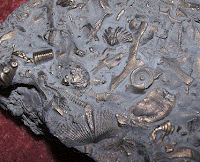 |
| Half a dozen different kinds of fossils |
We already took eHowian Karen S. Garvin to task for her version of the same post earlier this year, in which we noted that the word "Shell" in the title is so ambiguous as to make the question impossible to answer in the 300-500 words allotted to DMS writers. Ambiguous or not, Garvin did a lousy job... and Tapp failed to improve on it. Here's her first gaffe:
"One of the most common samples of fossils include different types of fossilized shell, these are also called ammonites, which are fossils of coiled up shells."
- "Fossils... are formed on a rock."
- "...try to match up the unique markings on the shell with glossaries found online on natural history museum websites to try to work out what type of animal left the marking."
- "Brachiopods are non-coiled shell fossils and can be black, white, brown or grey²."
- "...echinoids... gastropods... Look closely at your fossil and try to work out which one of these classifications fits best."
| Wow: now those are helpful bits of advice. We notice she didn't mention any of several other phyla and classes that produce shelly remains; including corals, pelecypods, bryozoa, echinoderms... No, all she did was reword some of Garvin's more puzzling prose (e.g., "Patterns on the shell... can be useful in identifying species," which reappeared in number 2 above). No, we're pretty sure that Tapp's version is even more useless than Garvin's had been. No wonder our staffer tapped Fiona's bushwa to be our Dumbass of the Day. After all, what can you say about someone whose bio says she's "[A] a former... masters degree holder"? Did the university claw the degree back? We don't blame them... |
¹ The line is in Osborne's song, "Dracula Moon."
² It appears that Fiona lives in Canada...
copyright © 2018-2023 scmrak
SI - PALEONTOLOGY
No comments:
Post a Comment